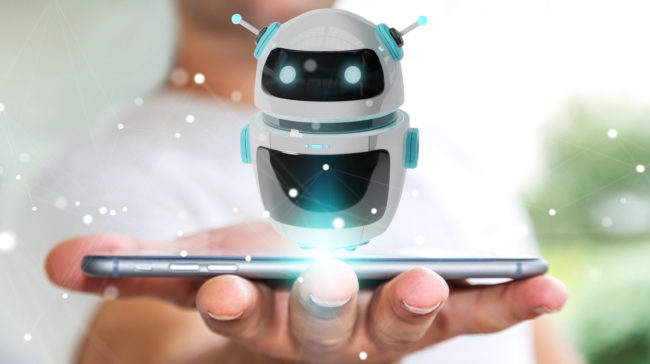It is easy to overlook that as we go about our daily lives, technology subtly changes how we all work, live, socialise and interact with businesses. Thirty years ago, the Internet was a curious new gimmick, today – try living life without it. Or, the connected cloud services like banks and online working that live through it. Twenty years ago, people went to concerts and joined in, now they share grainy footage with awful audio on social media, so pros and cons!
Progress is inevitable, and among the regular waves of new technology and services changing how businesses and people interact, communicate and get things done; chatbots, virtual assistants and AI are on an unstoppable surge into our lives. But where did this technology come from? Does it really work, and how will it affect us in the near future?
A potted history of chatbots
The first official chatbots date back to the sixties, incubated in early computer laboratories like Massachusett Institute of Technology’s ELIZA developed by Joseph Weizenbaum and colleagues.
Following scripts, early bots wouldn’t fool anyone today, but the technology and use of natural language processing in later efforts started to signal useful applications. Take the PARRY bot, developed in the early seventies by American psychiatrist Kenneth Colby in 1972 to demonstrate the condition of schizophrenia, it showed that chatbots could talk smarter and were approaching levels of sophistication to challenge the Turing Test.
As digital computers and faster hardware arrived, those lofty science and medical goals have since broadened, and bots have moved from the labs into the business world, this neat infographic provides a key guide to those early bots. It wasn’t long before a whole generation of gamers were interacting with bots. Anyone who played a text adventure like Zork or The Hobbit on an old computer will be familiar with the concept of typing messages and getting various responses based on the input. From those branching paths, many a chatbot idea was born.
With the rise of the Internet, and easy access to computers and then smartphones, the world saw what was once sci-fi become reality. So much so, the 90s-designed bot Richard Wallace’s ALICE, even inspired the 2013 movie Her by Spike Jonze.
As awareness of bots grew, businesses have adopted them as yet another IT tool, using the results to improve their efficiency and performance. But whereas those early systems were totally isolated, today’s bot are a part of the connected world and able to access huge amounts of data personal to you, the subject you are discussing or helpful business information.
Now they are reaching every corner where technology exists to help make out lives easier, helping support us in customer service, offer advice on health and telemedicine, provide information when the airport travel system is down and many more.
So, what is a modern chatbot?
The chatbots we use today are the distant relatives of those early efforts, many are simply chat-enabled versions of the customer call center scripts that people are already used to dealing with. They follow the same paths and branches, providing information and escalating the issue if the bot gets stuck.
The key benefit is that any chatbot can handle hundreds or thousands of users at once, while working 24 hours a day. This frees up the customer service agents for more complicated issues or those that require the human touch. People are starting to like their chatbots, as statistics show, but it will take some time.
Even a basic scripted bot can save a large company many thousands of hours of worker time, and if a startup or small company lacks the resources, bots can act in a reception, concierge or service role until they can hire people, adding huge value to the business.
The key advantage of a bot is that it follows the rules. Call center workers are under immense pressure to hit targets, to win and keep customers. Maintaining job satisfaction in this environment is a serious challenge, and by letting the bots follow the mundane rules, and only escalating calls of value to agents, the bots can help workers have a more satisfying job and the business to meet those targets.
Chatbots for customer service are a win-win. But as we race further into the 21st century, the tech world is focused on artificial intelligence as technology providers desperately try to put the “smart” in smartphone, smart home, and smart business. The bot can be created by the company using in-house tools, cloud services or they can outsource the design.
Adding intelligence to bots
Look for any chatbot service now and they are all throwing artificial intelligence (AI) as a feature into their marketing. The truth is bots can be imbued with intelligence in a number of ways. The first is through natural language processing (NLP), with machine learning (ML) helping systems understand data better, while true AI uses these and other technologies to improve the service a product offers.
Here, the bot is on the lookout for keywords or phrases (know as part-of-speech tagging) so it better understands what the user is asking, and doesn’t have to rely completely on scripted questions and replies. Bots can also break down sentences into words and search for meanings (word segmentation) adding high values to the keywords. Adding NLP adds some complexity to the bot, but it can still be built by a small team and adds an improved layer of understanding.
True artificial intelligence is still a work in progress. Current efforts rely largely on powerful cloud services crunching large sets of data to extract meaning. AI chatbots could have a general discussion on almost any subject, learning as they go, in this respect, a scripted bot is a fixed point, but AI can learn and improve.
In relation to businesses, AI bots can find information that makes conversations with the bot more relevant. They are also able to link to statistics engines to find nuances in conversation that might otherwise be missed.
That can be applied to any field, but will definitely be of value when it comes to dealing with customers who are expressing annoyance or uncertainty with the bot. The AI can recognize stress or alarm, and change its messaging accordingly. Consider how useful that will be in the area of mental health or deal with governmental issues.
As the AI-class of bots become smarter, they can also act a unifying tool for a business, the same bot that handles customer service can handle internal worker needs like absence, form filling, and other tasks. Bots will merge with virtual assistants and link to external services to make bots all the more useful.
Into the future, the bot can use AI features like image processing to understand people who have a problem best expressed by taking a photo of a faulty part or an item they need replacing but lack the details for. AIs can also be used for planning, helping workers arrange convenient times for meetings or retrieving information buried in another system. All of these areas can combine and be used in devices like an Amazon Echo to create a single point of contact for many services, just like how you can order a pizza or an Uber.
How chatbots will change the world
Chatbots have surged from a trickle a few years ago to a wave sweeping through business today. There’s already a dramatic shift in customer service businesses using them to improve their service. yet, there is still much more to do, and further to go.
As more businesses adopt bots they will become more accessible moving from phones and laptops to kiosks in hotels and airports to support travelers, or discretely in doctor’s offices to speed up bookings and diagnosis.
As people get more used to bots, they will expect them to take up other tasks, so that customer service bot could help make appointments, such as bookings for garages or hair appointments, improving the service offering. Then, as businesses recognize the value in bots, they might add even more features to them, or invest in smarter bots that can do more for the business.
Most bots are point solutions addressing a particular issue. Soon the bot mixed with voice response and wider knowledge will act as a wide-area solution as described in the previous section. Chatbots are already adding voice-features to make them more accessible, and multilingual bots (using AI for translation) will help businesses deal with customers or prospects around the world, where that 24/7 feature will really come in useful. .
How chatbots can go wrong
We’re still in the early stages of chatbot evolution, so naturally, there have been plenty of mistakes already. Some bots have failed to deliver on the basic features of a chat, which is easily fixed in a script.
Early AI bots have been prone to misdemeanor tinkering by users, turning them into foul-mouthed machines, that needed removing and updating. These are lessons that vendors and providers and already learning.
A few examples made the press, but most you won’t have heard of, as the bot in question was such a low-key launch, that no one noticed. That’s one of the more common business mistakes, only noticeable by the sight of developers sobbing “Why does no one talk to it!” into their after-work latte or pints.
As trust and popularity grow, then bots will become higher-profile targets for hackers and we have yet to see any major stories of data theft from a bot. When that happens we will go through the same road bumps that online banking, social media and other aspects of our digital lives went through.
Once we’re over them, there will be issues of identity, trust, and accuracy when bots start dealing with medical or contract issues, again there will be failures and lessons to learn. Beyond that, we enter the world where bots are an everyday part of all our lives, used by all businesses just as smartphone apps are today.
We won’t notice they will have changed due to the years it will take that adoption. But bots are an inevitable part of the future and an exciting one for users, businesses, and governments as a method of mass interaction and communication.





One response to “Chatbots: What are they and how will they change the world?”
[…] still to launch their first bot, or understand what the technology is (for more on chatbot basics, this magazine has a guide here), there remains a huge audience and market for […]